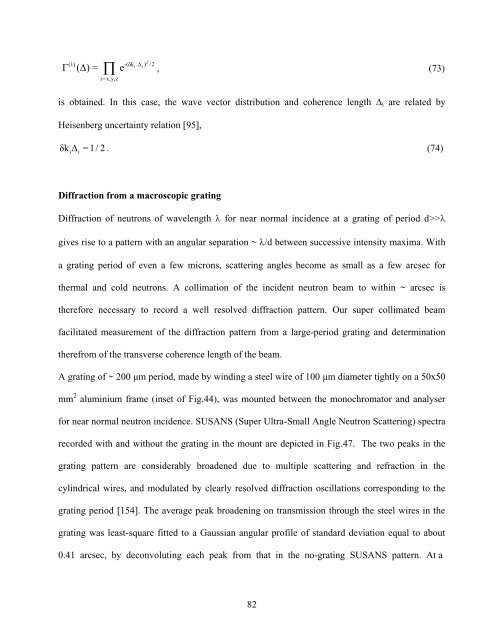PHYS01200804001 Sohrab Abbas - Homi Bhabha National Institute
PHYS01200804001 Sohrab Abbas - Homi Bhabha National Institute
PHYS01200804001 Sohrab Abbas - Homi Bhabha National Institute
You also want an ePaper? Increase the reach of your titles
YUMPU automatically turns print PDFs into web optimized ePapers that Google loves.
2<br />
(1)<br />
-(δk i .Δ i ) /2<br />
Γ (Δ) = e , (73)<br />
i=x,y,z<br />
is obtained. In this case, the wave vector distribution and coherence length i are related by<br />
Heisenberg uncertainty relation [95],<br />
δk Δ = 1/ 2 . (74)<br />
i<br />
i<br />
Diffraction from a macroscopic grating<br />
Diffraction of neutrons of wavelength for near normal incidence at a grating of period d>><br />
gives rise to a pattern with an angular separation ~ /d between successive intensity maxima. With<br />
a grating period of even a few microns, scattering angles become as small as a few arcsec for<br />
thermal and cold neutrons. A collimation of the incident neutron beam to within ~ arcsec is<br />
therefore necessary to record a well resolved diffraction pattern. Our super collimated beam<br />
facilitated measurement of the diffraction pattern from a large-period grating and determination<br />
therefrom of the transverse coherence length of the beam.<br />
A grating of ~ 200 μm period, made by winding a steel wire of 100 μm diameter tightly on a 50x50<br />
mm 2 aluminium frame (inset of Fig.44), was mounted between the monochromator and analyser<br />
for near normal neutron incidence. SUSANS (Super Ultra-Small Angle Neutron Scattering) spectra<br />
recorded with and without the grating in the mount are depicted in Fig.47. The two peaks in the<br />
grating pattern are considerably broadened due to multiple scattering and refraction in the<br />
cylindrical wires, and modulated by clearly resolved diffraction oscillations corresponding to the<br />
grating period [154]. The average peak broadening on transmission through the steel wires in the<br />
grating was least-square fitted to a Gaussian angular profile of standard deviation equal to about<br />
0.41 arcsec, by deconvoluting each peak from that in the no-grating SUSANS pattern. At a<br />
82
















